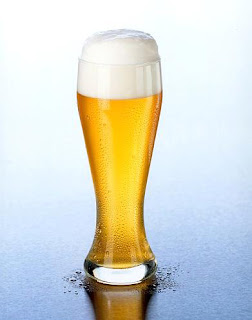In order to understand the brewing process, you first have to
understand the ingredients that go in to making beer. Over these couple of
posts, I will be discussing in short what each ingredient does to a beer. Now,
we already covered hops. They are what gives beer it's bitterness and
citrusy/floral aroma. This week, we are moving over to malt, the ingredient
that really gives beer almost every essential characteristic that determines
just what style the beer is.
 |
| icture Showing Different Range of Malts |
Malts are the ingredient in beer that balances out the bitterness that
hops give. They create the sugars that are essential in giving the beer it's
alcohol content and carbonation. The malts also give the beer it's color. The
lighter the beer, the less amount of time that the malts were put into a kiln
or dried. The darker the beer, the longer the malts have been roasted or
kilned. Without malts, beer would be so bitter that it would be impossible to
enjoy. Not only that, it would most likely always be green and would not have
the visual and taste characteristics that it has.
 |
| Malts give beer it's color and sweetness. |
Malting actually defines a process in which grains, like barley and
wheat, are taken and brought to a state that forces them to release the
starches and sugars that are essential in the fermentation of beer. What
happens in the process of malting is actually pretty simple. When the grains
are brought in, they are first soaked in water. Once soaked, they are taken out
and drained. Then the grains are left to germinate which activates the process
in which the starches that are in the grain become converted into sugars. This
is important because the sugar is what the yeast feeds on to create the alcohol
and carbonation of beer. (More on this subject in a later post.)
When the seeds of the grain begin to sprout, they are put into a kiln
or oven and dried so that the enzymes do not continue to do their work and end
up ruining the malt so that it can't be used. This process can define the
flavors that and contributed by the malts. Base malts are kilned for the least
amount of time and are usually the main ingredient to any beer recipe. The
Crystal or Caramel malts come about my allowing the enzymes in the grains to
break down carbohydrates to sugars before being put into the kiln. These malts
tend to lend lighter flavors and color to beer like toast, biscuit, or nutty.
These malts vary in a range of color and flavors that they impart on the beer. When
these grains are roasted, they are put in the oven at a higher temperature that
causes them to become a darker brown color and even sometimes black. These
roasted malts give characteristics of burnt, chocolate, and coffee to beer. An
example of a beer that uses these roasted malts is Guinness. Their brewing
process, including how they uses their malts, is described HERE.
 |
| Malts in different states of roasting. |
Upon being dried, or roasted fully, the grains are then crushed and put to soak in hot water. This creates the mash, where the enzymes are reactivate and become accelerated within a short period of time. This causes the last bit of starch in the mash to become broken down into sugar. Once this is done, the hops and are added to the boiling mixture. Once cooled down a bit, the yeast is added, thus making the mixture that will become one of the most infamous beverages around the world, beer!
So there is a little bit of information about malts. Hopefully you have
gotten a better understand about an ingredient that is crucial to the making of
beer.
What is your favorite Stout? What is it about that Stout that you prefer over other Stouts?





